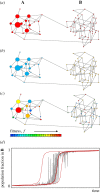On the networked architecture of genotype spaces and its critical effects on molecular evolution
- PMID: 29973397
- PMCID: PMC6070719
- DOI: 10.1098/rsob.180069
On the networked architecture of genotype spaces and its critical effects on molecular evolution
Abstract
Evolutionary dynamics is often viewed as a subtle process of change accumulation that causes a divergence among organisms and their genomes. However, this interpretation is an inheritance of a gradualistic view that has been challenged at the macroevolutionary, ecological and molecular level. Actually, when the complex architecture of genotype spaces is taken into account, the evolutionary dynamics of molecular populations becomes intrinsically non-uniform, sharing deep qualitative and quantitative similarities with slowly driven physical systems: nonlinear responses analogous to critical transitions, sudden state changes or hysteresis, among others. Furthermore, the phenotypic plasticity inherent to genotypes transforms classical fitness landscapes into multiscapes where adaptation in response to an environmental change may be very fast. The quantitative nature of adaptive molecular processes is deeply dependent on a network-of-networks multilayered structure of the map from genotype to function that we begin to unveil.
Keywords: adaptive multiscapes; genotype–phenotype map; molecular promiscuity; network-of-networks; phenotypic plasticity; punctuated dynamics.
© 2018 The Authors.
Conflict of interest statement
We declare we have no competing interests.
Figures




Similar articles
-
Adaptive multiscapes: an up-to-date metaphor to visualize molecular adaptation.Biol Direct. 2017 Feb 28;12(1):7. doi: 10.1186/s13062-017-0178-1. Biol Direct. 2017. PMID: 28245845 Free PMC article.
-
The space of genotypes is a network of networks: implications for evolutionary and extinction dynamics.Sci Rep. 2017 Oct 23;7(1):13813. doi: 10.1038/s41598-017-14048-x. Sci Rep. 2017. PMID: 29062002 Free PMC article.
-
From genotypes to organisms: State-of-the-art and perspectives of a cornerstone in evolutionary dynamics.Phys Life Rev. 2021 Sep;38:55-106. doi: 10.1016/j.plrev.2021.03.004. Epub 2021 May 21. Phys Life Rev. 2021. PMID: 34088608 Review.
-
Virus Evolution on Fitness Landscapes.Curr Top Microbiol Immunol. 2023;439:1-94. doi: 10.1007/978-3-031-15640-3_1. Curr Top Microbiol Immunol. 2023. PMID: 36592242
-
How does genetic architecture affect eco-evolutionary dynamics? A theoretical perspective.Philos Trans R Soc Lond B Biol Sci. 2022 Jul 18;377(1855):20200504. doi: 10.1098/rstb.2020.0504. Epub 2022 May 30. Philos Trans R Soc Lond B Biol Sci. 2022. PMID: 35634922 Free PMC article. Review.
Cited by
-
Getting higher on rugged landscapes: Inversion mutations open access to fitter adaptive peaks in NK fitness landscapes.PLoS Comput Biol. 2022 Oct 31;18(10):e1010647. doi: 10.1371/journal.pcbi.1010647. eCollection 2022 Oct. PLoS Comput Biol. 2022. PMID: 36315581 Free PMC article.
-
Degeneracy and genetic assimilation in RNA evolution.BMC Bioinformatics. 2018 Dec 27;19(1):543. doi: 10.1186/s12859-018-2497-3. BMC Bioinformatics. 2018. PMID: 30587112 Free PMC article.
-
Taming out-of-equilibrium dynamics on interconnected networks.Nat Commun. 2019 Nov 22;10(1):5314. doi: 10.1038/s41467-019-13291-2. Nat Commun. 2019. PMID: 31757969 Free PMC article.
-
Footprints of a Singular 22-Nucleotide RNA Ring at the Origin of Life.Biology (Basel). 2020 Apr 25;9(5):88. doi: 10.3390/biology9050088. Biology (Basel). 2020. PMID: 32344921 Free PMC article.
-
Robustness and innovation in synthetic genotype networks.Nat Commun. 2023 Apr 28;14(1):2454. doi: 10.1038/s41467-023-38033-3. Nat Commun. 2023. PMID: 37117168 Free PMC article.
References
-
- Lyell C. 1830. Principles of geology, being an attempt to explain the former changes of the Earth's surface, by reference to causes now in operation. London, UK: John Murray.
-
- Eldredge N, Gould SJ. 1972. Punctuated equilibria an alternative to phyletic gradualism. In Models in paleobiology (ed. Schopf TJM.), pp. 82–115. San Francisco: Freeman Cooper.
-
- Solé RV, Manrubia SC, Benton MJ, Bak P. 1997. Self-similarity of extinction statistics in the fossil record. Nature 388, 764–767. (10.1038/41996) - DOI
Publication types
MeSH terms
LinkOut - more resources
Full Text Sources
Other Literature Sources

